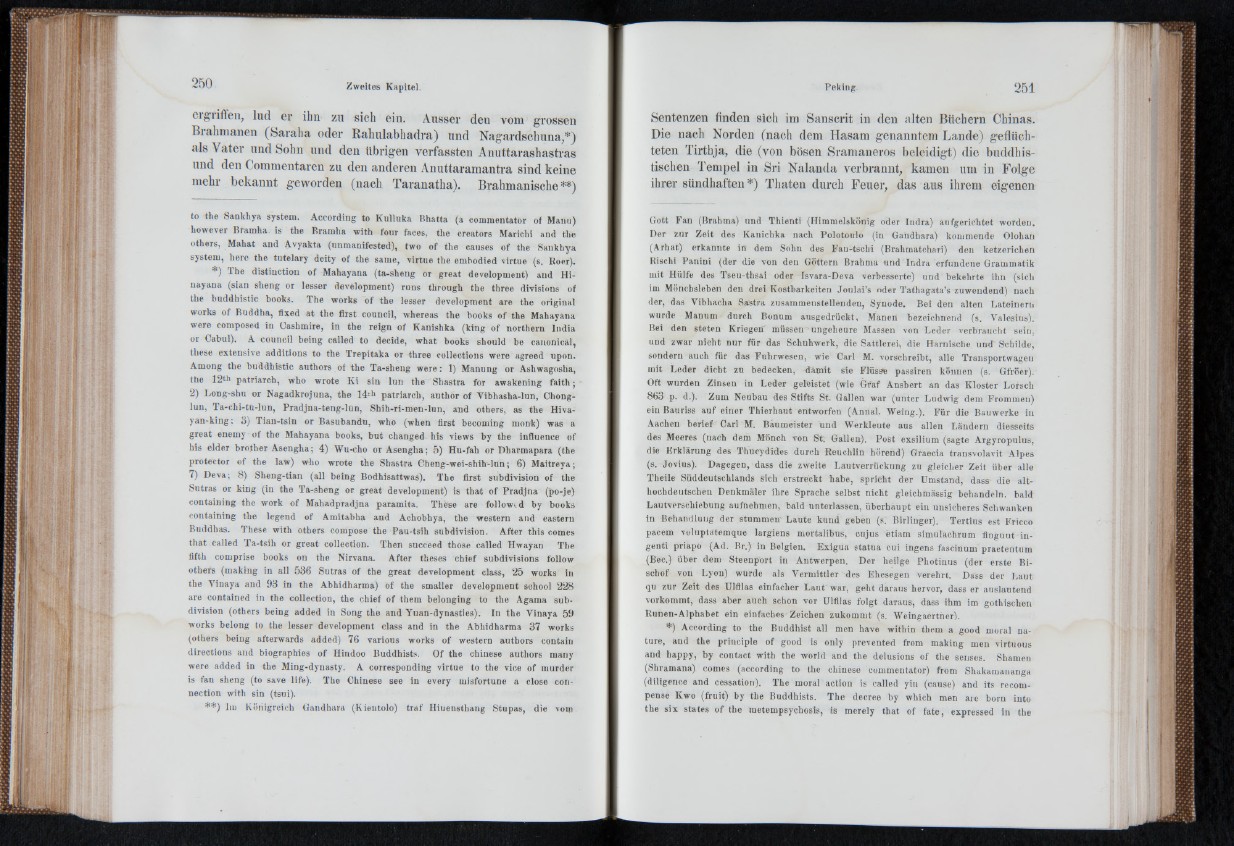
ei griffen, lud er ihn zu sich ein. Ausser den vom grossen
Brahmanen (Saraha oder Rahulabhadra) und Nagardschuna,*)
als Vater und Sohn und den übrigen verfassten Anuttarashastras
und den Commentaren zu den anderen Anuttaramantra sind keine
mehr bekannt geworden (nach Taranatha). Brahmanische**)
to the Sankhya system. According to Kulluka Bhatta (a commentator of Mann)
however Bramha. is the Bramha with four faces, the creators Marichi and the
others, Mahat and Avyakta (unmanifested), two of the causes of the Sankhya
system, here the tutelary deity of the same, virtue the embodied virtue (s. Roer).
*) The distinction of Mahayana (ta-sheng or great development) and Hi-
nayana (sian strong or lesser development) runs through the three divisions of
the buddhistic books. The works of the lesser development are the original
works of Buddha, fixed at the first council, whereas the books of the Mahayana
were composed in Cashmire, in the reign of Kanishka (king of northern India
or Cabul). A council being called to decide, what books should be canonical,
these extensive additions to the Trepitaka or three collections were agreed upon.
Among the buddhistic authors of the Ta-sheng were: 1) Manung or Ashwagosha,
the 12th patriarch, who wrote Ki sin lun the Shastra for awakening fa ith ; -
2) Long-shu or Nagadkrojuna, the 14‘h patriarch, author of Yibhasha-lun, Chong-
lun, Ta-chi-tu-lun, Pradjna-teng-lun, Shih-ri-men-lun, and others, as the Hiva-
yan-king: 3) Tian-tsin or Basubandu, who (when first becoming monk) was a
great enemy of the Mahayana books, but changed his views by the influence of
his elder brother Asengha; 4) Wu-cho or Asengha; 5) Hu-fah or Dharmapara (the
protector of the law) who wrote the Shastra Cheng-wei-shih-lun; 6) Maitreya;
7) Deva; 8) Sheng-tian (all being Bodhisattwag). The first subdivision of the
Sutras or king (in the Ta-sheng or great development) is that of Pradjna (po-je)
containing the work of Mahadpradjna paramita. These are followed by books
containing the legend of Amitabha and Achobhya, the western and eastern
Buddhas. These with others compose the Pau-tsih subdivision. After this comes
that called Ta-tsih or great collection. Then succeed those called Hwayan The
fifth comprise books on the Nirvana. After theses chief subdivisions follow
others (making in all 536 Sutras of the great development class, 25 works in
the Vinaya and 93 in the Abhidharma) of the smaller development school 228
are contained in the collection, the chief of them belonging to the Agama subdivision
(others being added in Song the and Yuan-dynasties). In the Yinaya 59
works belong to the lesser development class and in the Abhidharma 37 works
(others being afterwards added) 76 various works of western authors contain
directions and biographies of Hindoo Buddhists. Of the Chinese authors many
were added in the Ming-dynasty. A corresponding virtue to the vice of murder
is fan sheng (to save life). The Chinese see in every misfortune a close connection
with sin (tsui).
**) 1m Koiiigreich Gandhara (Kientolo) traf Hiuensthang Stupas, die vom
Sentenzen finden sich im Sanscrit in den alten Büchern Chinas.
Die nach Norden (nach dem Hasam genanntem Lande) geflüchteten
Tirthja, die (von bösen Sramaneros beleidigt) die buddhistischen
Tempel in Sri Nalanda verbrannt, kamen um in Folge
ihrer sündhaften *) Thaten durch Feuer, das aus ihrem eigenen
Gott Fan (Brahma) und Thienti (Himmelskönig oder Indra) anfgerichtet worden.
Der zur Zeit des Kanichka nach Polotouio (in Gandhara) kommende Olohau
(Arhat) erkannte in dem Sohn des Fau-tschi (Brahmatchari) den ketzerichen
Kischi Panini (der die von den Göttern Brahma und Indra erfundene Grammatik
mit Hülfe des Tseu-thsai oder Isvara-Deva verbesserte) und bekehrte ihn (sich
im Möncbsleben den drei Kostbarkeiten Jeulai’s oder Tathagata’szuwendend) nach
der, das Vibhacha Sastra zusammenstellenden, Synode. Bei den alten Lateinern
wurde Manum durch Bonum ausgedrückt, Manen bezeichnend (s. Valesius).
Bei den steten Kriegen" müssen'ungeheure Massen von Leder verbraucht sein,
und zwar nicht nur für das Schuhwerk, die Sattlerei, die Harnische u ih T Schilde,
sondern auch für das Fuhrwesen, wie Carl M. vorschreibt, alle Transportwagen
mit Leder dicht zu bedecken, damit sie Flüsse passiren können (s. Gfröer).
Oft wurden Zinsen in Leder geleistet (wie Graf Ansbert an das Kloster Lofsch
863 p. d.). Zum Neubau des Stifts St. Gallen war (unter Ludwig dem Frommen)
ein Bauriss auf einer Thierhaut entworfen (Anüal. Weing.). Für die Bauwerke in
Aachen berief Carl M. Baumeister und Werkleute aus allen Ländern diesseits
des Meeres (nach dem Mönch von St: Gallen). Post exsilium (sagte Argyropulus,
die Erklärung des Thucydides durch Reuchlin hörend) Graecia transvolavit Alpes
(s. Jovius). Dagegen, -dass die zweite Lautverrückung zu gleicher Zeit über alle
Theile Süddeutschlands Sich erstreckt habe, spricht der Umstand, dass die a lthochdeutschen
Denkmäler ihre Sprache selbst nicht gleichmässig behandeln, bald
Lautverschiebung aufnehmen, bald unterlassen, überhaupt ein unsicheres Schwanken
in Behandlung der stummen'Laute kund geben (si Birlinger). Tertius est Fricco
pacem voluptätemque largiens mortalibus, cujus etiam simulachrum flnguut in-
genti priäpo (Ad. Br.) in Belgien. Exigua statua cui ingens fascinum praetentum
(Bec.) über dem Steenport in Antwerpen. Der heilge Photinus (der erste Bischof
von Lyon) wurde als Vermittler des Ehesegen verehrt. Dass der Laut
qu zur Zeit des Ulfllas einfacher Laut war, geht daraus hervor, dass er anslautend
vorkommt, dass aber auch schon vor Ulfllas folgt daraus, dass ihm im gothischen
Runen-Alphabet ein einfaches Zeichen zukommt (s. Weingaertner).
*) According to the Buddhist all men have within them a good moral nature,
and the principle of good is only prevented from making men virtuous
and happy, by contact with the world and the delusions of the senses. Shamen
(Shramana) comes (according to the Chinese commentator) from Shakamananga
(diligence and cessation). The moral action is called yiu (cause) and its recompense
Kwo (fruit) by the Buddhists. The decree by which men are born into
the six states of the metempsychosis, is merely that of fate, expressed in the